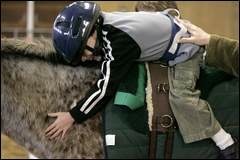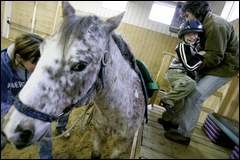
Originally published in The Blade on Sunday, August 5, 2007
BY RYAN E. SMITH
BLADE STAFF WRITER
Darren Bedegarea’s doctors will tell you he has cerebral palsy.
His physical therapists will tell you the 9-year-old has limited mobility.
But all that really matters at the moment is something anyone can tell you: Darren has the giggles.
Sitting on a mottled pony named Dusty, his staccato-like laughs come out strong and short. He’s giddy for a little giddyup.
‘‘Walk on!’’ Darren commands. Always compliant, Dusty moves ahead, slow and steady. It’s an apt parallel to Darren, whose weekly riding sessions with Dusty were studied this spring in the hope that they would lead to his own steady — and significant — improvement in his ability to walk on.
The treatment is called hippotherapy — ‘‘hippo’’ is Greek for ‘‘horse’’ — and it’s been in use for 20 years in this country, but without much quantitative research to support it. Darren is one of six children with neurological problems who participated in a 10-week study by two physical therapists from St. Vincent Mercy Children’s Hospital examining the practice’s usefulness.
It started in March when Darren visited the motion analysis lab at the University of Toledo.
There, he was fitted with some reflective markers and electrodes that allowed computers to turn his movements into 3-D animation.

Usually using a wheelchair, Darren walked back and forth across the room with the help of a walker. He moved on tip-toes, determined and deliberate.
The idea was that riding a horse would help Darren’s muscle strength, balance, and coordination.
‘‘His muscles are spastic.
They’re tight,’’ explained Tracey Lewis, one of the physical therapists leading the study that she hopes will educate medical professionals and insurance companies.
‘‘The horse’s movement helps relax those muscles and then again allows the body to experience more normal movement.’’
That is possible because a horse’s motion closely mimics that of a human walking, so a rider’s pelvis is moved and muscles are stretched just as they would if they were functioning naturally.
But Darren wasn’t concerned with any of that when he first got to sit on Dusty at TimberWolff Stables in Providence Township. He was able to do little more than smile and laugh.
As the horse was led around in circles, Darren did simple exercises while atop his steed — holding his arms out like an airplane, throwing and catching a ball, touching his head — to challenge his balance.
To him it was just fun. Each of his three brothers had a sport, and now he did too—horse riding.
All the while, his mother, Dawn, watched carefully from a nearby bench, legs crossed, leaning forward to get a better view.
The Holland mom knew something was wrong with her youngest son when he was 8 months old.
‘‘He wasn’t crawling or sitting up like a normal child,’’ she said.
Before he had spinal surgery in 2003, it was extremely difficult for him to walk. Now, each week he seems to be more confident, more flexible.
‘‘It’s improved his overall strength and endurance. We’re seeing great progress,’’ said Betsy Hyde, the other physical therapist working with Darren. ‘‘His trunk control is much better. He’s sitting up straighter and taller, and those are all the basics that help you to walk better.’’
The aim, which they hope will be confirmed by a follow-up session at UT, was that Darren would show lasting mechanical changes in how he tried to walk.
This isn’t the end of the trail for young Darren, who rode weekly for 30 minutes a session. He still walks with difficulty, and his mom said she’ll continue to bring him to TimberWolff even though his part in the study, funded by the St. Vincent Mercy Medical Center Foundation, is over.
Good thing, because Darren had no desire to quit. At one point during his final session, he leaned all the way forward, embracing the pony in a deep, long hug. He held the embrace for several seconds, reluctant to part.
Once he did, though, his mind already was racing forward, especially when he saw some miniature horses and Shetland ponies milling behind a nearby fence.
‘‘What are those?’’ Darren asked, still smiling. ‘‘Can I ride them?’’






Riding therapy program’s goal is to improve child’s mobility
Darren Bedegarea, 9, is helped onto Dusty by physical therapist Tracey Lewis during a hippotherapy session at TimberWolff Stables. (THE BLADE/ANDY MORRISON )




He holds out his arms to mimic physical therapist Tracey Lewis in an exercise to improve balance. (THE BLADE/ANDY MORRISON)
Darren hugs Dusty during a hippotherapy session. (THE BLADE/ANDY MORRISON)